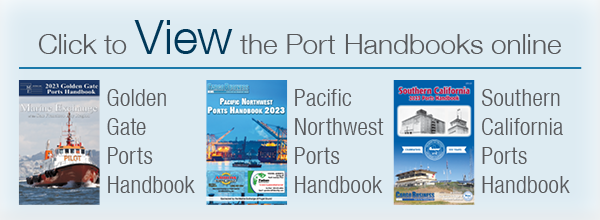|
By William DiBenedetto, CBN Feature Editor
The thing about port productivity is that it's not only about what individual ports are doing, it's also about carrier decisions, logistics supply chains and shipper/manufacturer distribution channels.
Added to this often uneasy and complicated mix is the mega-ship factor, as a new generation of huge vessels come on-line in large numbers. At this stage it looks like West Coast ports could be the early "winners." But is winning the mega-ship game really worth it? The jury is still out.
French shipping giant CMA CGM, the world's No. 3 container line after Maersk and MSC, recently said it will deploy six 18,000-TEU ships in the Transpacific market to accelerate its growth.
That decision goes against the grain of conventional wisdom, which holds that mega-ships should be confined mainly to the Asia-Europe trades, where there is enough deep water for them to operate efficiently.
But CMA CGM's decision "is in line with both the growth strategy set by the group in the United States and around the world and the optimization of its fleet," according to a company statement. "The flagship fleet of the group will henceforth be deployed on the most active and dynamic market to date — the Transpacific — and will support its development as well as that of its customers," the statement continued.
CMA CGM's Benjamin Franklin was the largest ship ever to call in the U.S. last December and was inaugurated on February 19 in Long Beach. It will remain in the Transpacific trade. Starting at the end of May, the line's other five super-sized vessels will join the fleet on the Pearl River Express line.
Drewry Maritime Research says these ships will become by far the largest ever to sail on the Transpacific, and has expressed reservations about West Coast ports' ability to "efficiently handle ships of this size on a regular basis." In a recent report, Drewry concluded that West Coast ports "are not yet in a position to handle 18,000-TEU containerships regularly and have much work to do in terms of improving productivity if they are to see them call on anything other than an ad-hoc basis."
Drewry has also questioned CMA CGM's contention that the six mega-ships will help accelerate growth in the Transpacific. "That statement has a whiff of spin about it as the size of ships deployed has no influence on cargo demand. More realistically, CMA CGM has realized that it has a surplus of big ships on the faltering Asia-Europe route and decided that the relatively stronger Asia-USWC route can take up some of that slack," Drewry said.
"As more megaships enter service, the industry is rapidly approaching a critical stage," said Tim Power, Drewry managing director. "To ensure the economics of vessel upsizing continue to benefit the entire supply chain, lines and ports need to work in a more coordinated manner," he said.
Working in a coordinated manner has not exactly been a hallmark of port and carrier relationships, and with cargo demand soft on the Transpacific, Drewry analysts say if more lines adopt CMA CGM's strategy without rationalizing the number of services it would hurt both rates and yield.
The shipper perspective from Hackett Associates founder Ben Hackett, who compiles Port Tracker statistics with the National Retail Federation, is sharply critical. He said the decision to add new mega-ships to routes between Asia and the West Coast runs the risk of chaos. "Does this make sense? Absolutely not," Hackett said. "It flies in the face of financial and economic wisdom and totally ignores the state of the freight market."
U.S. terminals are investing heavily to be "big ship ready" with moves such as raising the heights of container cranes so they can lift boxes stacked 10-high on deck, and making ship berths longer and deeper.
|

The Port of Long Beach has pegged more than $4 billion to expand its terminal and rail capacity, along with new bridge and road infrastructure. The soon-to-be-opened $1.3 billion Middle Harbor container terminal project, which the port says will be the world's first all-electric, fully automated terminal, will be able to accommodate 18,000-TEU vessels immediately and eventually will be able to handle ships of up to 24,000 TEUs. When the second phase of the project opens in 2019, it will have an annual capacity of around 3.4 million TEUs.
The vessel upsizing trend in the Asia-USWC will almost certainly continue, as carriers such as Maersk Line and CSCL have ordered 14,000-TEU vessels specifically for the trade.
Drewry has noted it's important for the West Coast ports to "step up" because they are losing some of their dominant market share to East Coast rivals, which will soon get a boost from the expanded Panama Canal. The canal is now scheduled to open in late June and will handle triple the maximum size of containerships that can call there.
The bottom line facing ports all over the world is that from now until 2019 carriers will need to find homes for 72 x 18,000+ TEU vessels. "There is much to be done," says Drewry. West Coast ports will have to gear up in terms of water depth, dock length, and cranes, "but there is also a need to improve the efficiency of how cargo is brought to and from the port complex via truckers (who are in short supply) and intermodal railroad."
Terminal automation will help to improve productivity, as would longer working hours to turn ports into 24/7 operations, but this would require more flexibility
from union longshore workers — and how likely is that?
Meanwhile, introducing too many mega-ships to the West Coast ports before they are fully ready would most likely worsen productivity, rather than improve it, and could add days to move boxes at terminals, thus undermining West Coast competitiveness versus the East Coast, says Lawrence Gross, president of Gross Transportation Consulting of New Jersey, writing in IHS Media.
"Although bigger ships may optimize line-haul costs, they impose significant additional costs to the terminals and other land-side operators," he said.
"When volumes don't grow, and cargo comes in ever-larger but more widely spaced chunks, coupled with the requirement to turn those big ships rapidly, the terminal needs more of everything: more land, more cranes, more shuttle units and other equipment to handle the same volume delivered in smaller, more frequent doses," he said.
Ocean carriers "hold the upper hand because of their ability to shift volume away from any terminal that doesn't meet their requirements," Gross writes. "The massive investment needed to support the mega-ships in effect became the cover charge just to stay in the game."
Carriers are mainly concerned with how long the
ship is tied up at berth, Gross adds. "What happens to the containers before and after they clear the ship's rail is a problem for the land-side players to deal with." he said.
Gross also poses a question that voices the fears of some industry insiders. "Will we look back a decade from now and see the (mega-ship) as an evolutionary dead end, a dinosaur that was too large to survive in a changing world?"
|





